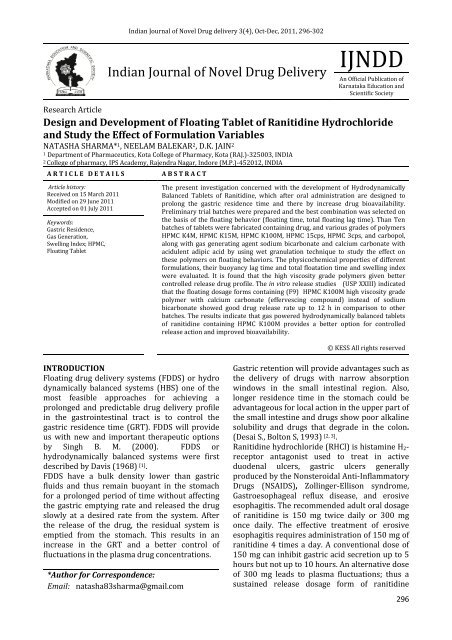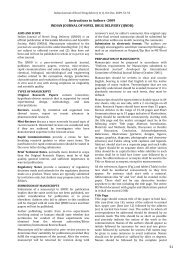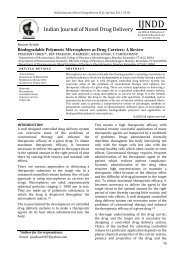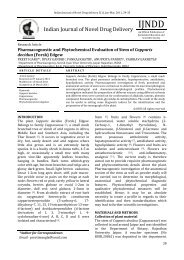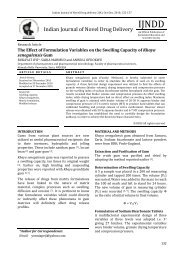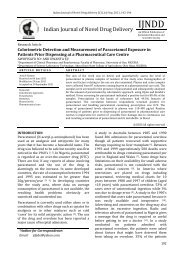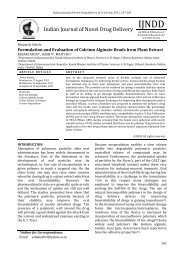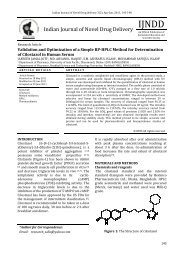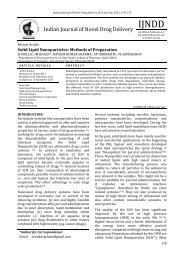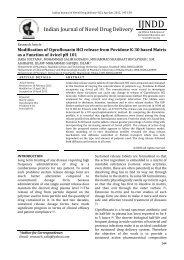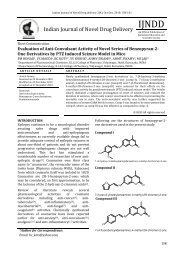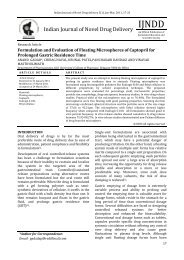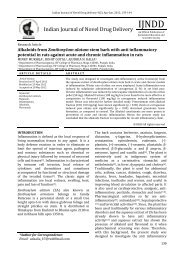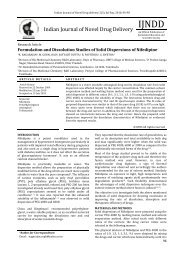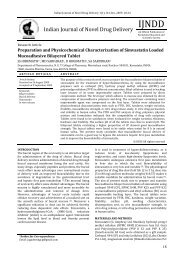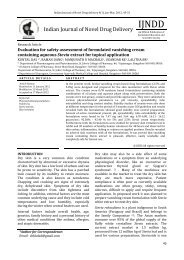Design and Development of Floating Tablet of Ranitidine ...
Design and Development of Floating Tablet of Ranitidine ...
Design and Development of Floating Tablet of Ranitidine ...
Create successful ePaper yourself
Turn your PDF publications into a flip-book with our unique Google optimized e-Paper software.
Indian Journal <strong>of</strong> Novel Drug delivery 3(4), Oct-Dec, 2011, 296-302<br />
Indian Journal <strong>of</strong> Novel Drug Delivery<br />
IJNDD<br />
An Official Publication <strong>of</strong><br />
Karnataka Education <strong>and</strong><br />
Scientific Society<br />
Research Article<br />
<strong>Design</strong> <strong>and</strong> <strong>Development</strong> <strong>of</strong> <strong>Floating</strong> <strong>Tablet</strong> <strong>of</strong> <strong>Ranitidine</strong> Hydrochloride<br />
<strong>and</strong> Study the Effect <strong>of</strong> Formulation Variables<br />
NATASHA SHARMA* 1 , NEELAM BALEKAR 2 , D.K. JAIN 2<br />
1 Department <strong>of</strong> Pharmaceutics, Kota College <strong>of</strong> Pharmacy, Kota (RAJ.)-325003, INDIA<br />
2 College <strong>of</strong> pharmacy, IPS Academy, Rajendra Nagar, Indore (M.P.)-452012, INDIA<br />
A R T I C L E D E T A I L S<br />
Article history:<br />
Received on 15 March 2011<br />
Modified on 29 June 2011<br />
Accepted on 01 July 2011<br />
Keywords:<br />
Gastric Residence,<br />
Gas Generation,<br />
Swelling Index; HPMC,<br />
<strong>Floating</strong> <strong>Tablet</strong><br />
A B S T R A C T<br />
The present investigation concerned with the development <strong>of</strong> Hydrodynamically<br />
Balanced <strong>Tablet</strong>s <strong>of</strong> <strong>Ranitidine</strong>, which after oral administration are designed to<br />
prolong the gastric residence time <strong>and</strong> there by increase drug bioavailability.<br />
Preliminary trial batches were prepared <strong>and</strong> the best combination was selected on<br />
the basis <strong>of</strong> the floating behavior (floating time, total floating lag time). Than Ten<br />
batches <strong>of</strong> tablets were fabricated containing drug, <strong>and</strong> various grades <strong>of</strong> polymers<br />
HPMC K4M, HPMC K15M, HPMC K100M, HPMC 15cps, HPMC 3cps, <strong>and</strong> carbopol,<br />
along with gas generating agent sodium bicarbonate <strong>and</strong> calcium carbonate with<br />
acidulent adipic acid by using wet granulation technique to study the effect on<br />
these polymers on floating behaviors. The physicochemical properties <strong>of</strong> different<br />
formulations, their buoyancy lag time <strong>and</strong> total floatation time <strong>and</strong> swelling index<br />
were evaluated. It is found that the high viscosity grade polymers given better<br />
controlled release drug pr<strong>of</strong>ile. The in vitro release studies (USP XXIII) indicated<br />
that the floating dosage forms containing (F9) HPMC K100M high viscosity grade<br />
polymer with calcium carbonate (effervescing compound) instead <strong>of</strong> sodium<br />
bicarbonate showed good drug release rate up to 12 h in comparison to other<br />
batches. The results indicate that gas powered hydrodynamically balanced tablets<br />
<strong>of</strong> ranitidine containing HPMC K100M provides a better option for controlled<br />
release action <strong>and</strong> improved bioavailability.<br />
© KESS All rights reserved<br />
INTRODUCTION<br />
<strong>Floating</strong> drug delivery systems (FDDS) or hydro<br />
dynamically balanced systems (HBS) one <strong>of</strong> the<br />
most feasible approaches for achieving a<br />
prolonged <strong>and</strong> predictable drug delivery pr<strong>of</strong>ile<br />
in the gastrointestinal tract is to control the<br />
gastric residence time (GRT). FDDS will provide<br />
us with new <strong>and</strong> important therapeutic options<br />
by Singh B. M. (2000). FDDS or<br />
hydrodynamically balanced systems were first<br />
described by Davis (1968) [1] .<br />
FDDS have a bulk density lower than gastric<br />
fluids <strong>and</strong> thus remain buoyant in the stomach<br />
for a prolonged period <strong>of</strong> time without affecting<br />
the gastric emptying rate <strong>and</strong> released the drug<br />
slowly at a desired rate from the system. After<br />
the release <strong>of</strong> the drug, the residual system is<br />
emptied from the stomach. This results in an<br />
increase in the GRT <strong>and</strong> a better control <strong>of</strong><br />
fluctuations in the plasma drug concentrations.<br />
*Author for Correspondence:<br />
Email: natasha83sharma@gmail.com<br />
Gastric retention will provide advantages such as<br />
the delivery <strong>of</strong> drugs with narrow absorption<br />
windows in the small intestinal region. Also,<br />
longer residence time in the stomach could be<br />
advantageous for local action in the upper part <strong>of</strong><br />
the small intestine <strong>and</strong> drugs show poor alkaline<br />
solubility <strong>and</strong> drugs that degrade in the colon.<br />
(Desai S., Bolton S, 1993) [2, 3] .<br />
<strong>Ranitidine</strong> hydrochloride (RHCl) is histamine H 2-<br />
receptor antagonist used to treat in active<br />
duodenal ulcers, gastric ulcers generally<br />
produced by the Nonsteroidal Anti-Inflammatory<br />
Drugs (NSAIDS), Zollinger-Ellison syndrome,<br />
Gastroesophageal reflux disease, <strong>and</strong> erosive<br />
esophagitis. The recommended adult oral dosage<br />
<strong>of</strong> ranitidine is 150 mg twice daily or 300 mg<br />
once daily. The effective treatment <strong>of</strong> erosive<br />
esophagitis requires administration <strong>of</strong> 150 mg <strong>of</strong><br />
ranitidine 4 times a day. A conventional dose <strong>of</strong><br />
150 mg can inhibit gastric acid secretion up to 5<br />
hours but not up to 10 hours. An alternative dose<br />
<strong>of</strong> 300 mg leads to plasma fluctuations; thus a<br />
sustained release dosage form <strong>of</strong> ranitidine<br />
296
Natasha Sharma et al / Indian Journal <strong>of</strong> Novel Drug Delivery 3(4), Oct-Dec, 2011, 296-302<br />
hydrochloride is desirable. The short biological<br />
half-life <strong>of</strong> drug (~2.5-3 hours) also favors<br />
development <strong>of</strong> these formulation. A traditional<br />
oral sustained release formulation releases most<br />
<strong>of</strong> the drug at the colon, thus the drug should<br />
have absorption window either in the colon or<br />
throughout the gastrointestinal tract. <strong>Ranitidine</strong><br />
is absorbed only in the initial part <strong>of</strong> the small<br />
intestine <strong>and</strong> has 50% absolute bioavailability.<br />
Moreover, colonic metabolism <strong>of</strong> ranitidine is<br />
partly responsible for the poor bioavailability <strong>of</strong><br />
ranitidine from the colon. These properties <strong>of</strong><br />
ranitidine hydrochloride do not favor the<br />
traditional approach to sustained release<br />
delivery. Hence, clinically acceptable sustained<br />
release dosage forms <strong>of</strong> ranitidine hydrochloride<br />
prepared with conventional technology may not<br />
be successful [4]. The present investigation<br />
applied a systematic approach to formulate the<br />
floating tablet <strong>of</strong> ranitidine with various grades<br />
<strong>of</strong> polymer hydroxyl propyl methylcellulose<br />
(HPMC) in various combinations. The prepared<br />
tablets were evaluated for physical parameters<br />
such as shape, dimension, hardness, friability<br />
test, weight variation test, buoyancy / floating<br />
Test, swelling index <strong>and</strong> drug content. All the<br />
tablets were evaluated for In vitro drug release<br />
studies [5,6] .<br />
MATERIALS AND METHODS<br />
<strong>Ranitidine</strong> was obtained as gift sample (Ranbaxy<br />
Lab Ltd, Dewas, India). Other chemical <strong>and</strong><br />
polymers such as hydroxyl propyl<br />
methylcellulose (HPMC K4M, K15M, K100M,<br />
15CPS <strong>and</strong> 3 CPS) was obtained as gift sample<br />
from Ranbaxy Lab Ltd, Dewas, India). All other<br />
reagents <strong>and</strong> chemicals used were <strong>of</strong> analytical<br />
grade.<br />
Preparation <strong>of</strong> <strong>Floating</strong> <strong>Tablet</strong> <strong>of</strong> <strong>Ranitidine</strong><br />
Hydrochloride<br />
<strong>Floating</strong> tablets containing <strong>Ranitidine</strong><br />
Hydrochloride were prepared by wet granulation<br />
process using 2% PVP K-30 in Isopropyl alcohol<br />
as a binding agent using varying concentrations<br />
<strong>of</strong> different grades <strong>of</strong> polymers with Carbopol<br />
934, sodium bicarbonate, calcium bicarbonate<br />
<strong>and</strong> adipic acid. Polymers <strong>and</strong> effervescent<br />
mixtures were blended in pestle <strong>and</strong> motor, 2%<br />
PVP-K30 solution in isopropyl alcohol was used<br />
as binder to form a moist mass. Granules were<br />
obtained by passing through the sieve no 12 the<br />
granules were dried at 45 ºC for 1 hour in oven<br />
dried granules were again passed through the<br />
sieve no. 22 <strong>and</strong> granules obtained was<br />
compressed in a tablet by using single punch<br />
h<strong>and</strong> operating tablet compression machine.<br />
Compositions <strong>of</strong> various formulation batches are<br />
shown in Table 1.<br />
In vitro evaluation <strong>of</strong> floating tablets:<br />
Evaluation was performed to assess the<br />
physicochemical properties <strong>and</strong> release<br />
characteristics <strong>of</strong> the developed formulations.<br />
Pre-compression parameters:<br />
a) Angle <strong>of</strong> Repose (θ):<br />
The frictional forces in a loose powder or<br />
granules can be measured by angle <strong>of</strong> repose.<br />
This is the maximum angle possible between the<br />
surface <strong>of</strong> a pile <strong>of</strong> powder or granules <strong>and</strong> the<br />
horizontal plane.<br />
The granules were allowed to flow through the<br />
funnel fixed to a st<strong>and</strong> at definite height (h). The<br />
angle <strong>of</strong> repose was then calculated by<br />
measuring the height <strong>and</strong> radius <strong>of</strong> the heap <strong>of</strong><br />
granules formed.<br />
tan θ = h/r<br />
θ = tan -1 (h/r)<br />
Where, θ = angle <strong>of</strong> repose<br />
h = height <strong>of</strong> the heap<br />
r = radius <strong>of</strong> the heap<br />
b) Compressibility Index:<br />
The flow ability <strong>of</strong> powder can be evaluated by<br />
comparing the bulk density (ρ o) <strong>and</strong> tapped<br />
density (ρ t) <strong>of</strong> powder <strong>and</strong> the rate at which it<br />
packed down [7]. Compressibility index was<br />
calculated by –<br />
Compressibility index (%) = ρ t – ρ o x 100<br />
ρ t<br />
Where ρ o = Bulk density g/ml<br />
ρ t = Tapped density g/ml.<br />
Post compression parameters:<br />
Physical Parameters<br />
The tablets were evaluated for shape, hardness<br />
(Monsanto hardness tester), thickness using<br />
calibrated varniear caliper, friability using Roche<br />
friabilator <strong>and</strong> weight variation test.<br />
Drug Content<br />
Twenty tablet <strong>of</strong> each formulation were crushed<br />
to powdered in pestle <strong>and</strong> motor <strong>and</strong> power<br />
equivalent to 100 mg <strong>of</strong> drug was added in 100<br />
ml <strong>of</strong> 0.1 N HCL (pH 1.2). The resulting solution<br />
called the stock solution <strong>and</strong> filters the resulting<br />
solution through 0.45 μm membrane, diluted<br />
suitably <strong>and</strong> analyzed for drug content<br />
spectrophotometrically at 315 nm using 0.1 N<br />
HCL as a blank [8] .<br />
297
Natasha Sharma et al / Indian Journal <strong>of</strong> Novel Drug Delivery 3(4), Oct-Dec, 2011, 296-302<br />
Table 1: Variation in final formulation by using various polymers<br />
Ingredients *<br />
Formulation batches<br />
F1 F2 F3 F4 F5 F6 F7 F8 F9 F10<br />
<strong>Ranitidine</strong> HCl 316 316 316 316 316 316 316 316 316 316<br />
HPMC K 100 80 - - - - - - 40 80 -<br />
HPMC K 15 MCR - 80 - - - - 40 40 - -<br />
HPMC K 4 MCR - - 80 - - 40 - - -<br />
HPMC 15 CPS - - - 80 - - - - 40<br />
HPMC 3 CPS - - - - 80 - - - - 40<br />
Sodium alginate - - - - - 80 - - - -<br />
Carbopol 934 20 20 20 20 20 20 20 20 20 20<br />
NaHCO3 50 50 50 50 50 50 50 50 - 50<br />
Caco3 - - - - - - - - 50 -<br />
Adipic acid 10 10 10 10 10 10 10 10 10 10<br />
PVP K-30 (w/v) 2% 2% 2% 2% 2% 2% 2% 2% 2% 2%<br />
Magnesium Stearate 1% 1% 1% 1% 1% 1% 1% 1% 1% 1%<br />
Talc 1% 1% 1% 1% 1% 1% 1% 1% 1% 1%<br />
Table 2: Various Pre-compression Parameters:<br />
Batches Bulk density Tapped Density Compressibility Remarks Angle <strong>of</strong> Repose Remarks<br />
(%)<br />
F1 0.357 0.434 17.74 Good 34°.43´ Possible flow<br />
F2 0.343 0.396 13.38 Good 31°.70´ Good flow<br />
F3 0.350 0.433 8.3 Good 32°.15´ Possible flow<br />
F4 0.350 0.408 14.21 Excellent 34°.07´ Possible flow<br />
F5 0.386 0.468 17.52 Excellent 34°.77´ Possible flow<br />
F6 0.364 0.413 11.84 Good 30°.96´ Good Flow<br />
F7 0.360 0.428 16.02 Excellent 35°.36´ Possible flow<br />
F8 0.340 0.383 12.74 Good 39°.09´ Possible flow<br />
F9 0.335 0.376 10.90 Good 39°.28´ Possible flow<br />
F10 0.355 0.457 22.31 Faire to possable 39°.47´ Possible flow<br />
Table 4: Swelling Index <strong>of</strong> various Formulations batches<br />
Time Swelling Index (%)<br />
F1 F2 F3 F4 F5 F6 F7 F8 F9 F10<br />
1 hrs. 12 15 19 16 16 12 15 19 26 16<br />
2 hrs. 29 35 30 20 25 29 35 30 34 25<br />
3 hrs. 48 62 56 40 42 48 62 56 60 42<br />
4 hrs. 68 85 72 61 63 51 75 72 71 63<br />
5 hrs. 97 95 89 70 69 64 85 89 96 69<br />
298
Natasha Sharma et al / Indian Journal <strong>of</strong> Novel Drug Delivery 3(4), Oct-Dec, 2011, 296-302<br />
Table 3: Various post compression evaluation parameters<br />
Batches<br />
Uniformity <strong>of</strong><br />
Hardness (kg.cm 2 )<br />
Friability<br />
Drug Content<br />
<strong>Floating</strong><br />
Total floating<br />
weight<br />
(%)<br />
(%)<br />
lag time<br />
Time (sec.)<br />
(mg)<br />
(s)<br />
F1 480.65 ±1.29 5 ± 0.5 0.96 97.78 300S >12 hrs<br />
F2 485.50 ±1.74 6 ± 0.7 0.77 97.15 145S >12 hrs<br />
F3 481.55 ±1.18 6.5 ± 0.4 0.93 98.42 188S >12 hrs<br />
F4 484.05 ±1.37 6 ± 0.5 0.84 94.63 68S 8hrs<br />
F5 485.65 ±1.49 5.5 ± 0.6 0.79 96.58 140S 7 hrs<br />
F6 483.49±1.49 6 ± 0.4 0.86 97.18 45S 7 hrs<br />
F7 485. 50 ±1.70 5 ± 0.5 0.85 98.13 180S >12 hrs<br />
F8 484.30 ±1.39 6.5 ± 0.6 0.76 97.47 240S >12 hrs<br />
F9 483.50 ±1.44 6 ± 0.7 0.89 97.83 420S >12 hrs<br />
F10 485.61 ±1.24 5 ± 0.5 0.98 98.13 110S 7 hrs<br />
At Initial Time After 65 seconds After 7 h After 12 h<br />
Figure 1: In vitro buoyancy studies<br />
Figure 2: <strong>Tablet</strong> prepared by effervescent technique by using adipic acid <strong>and</strong> calcium carbonate<br />
299
Natasha Sharma et al / Indian Journal <strong>of</strong> Novel Drug Delivery 3(4), Oct-Dec, 2011, 296-302<br />
% SWELLING INDEX<br />
100<br />
90<br />
80<br />
70<br />
60<br />
50<br />
40<br />
30<br />
20<br />
10<br />
0<br />
1 hrs. 2 hrs. 3 hrs. 4 hrs. 5 hrs.<br />
f1<br />
f2<br />
f3<br />
f4<br />
f5<br />
TIME<br />
Figure 3: Swelling index graph <strong>of</strong> formulation F1, F2, F3, F4 <strong>and</strong> F5<br />
% SWELLING INDEX<br />
100<br />
90<br />
80<br />
70<br />
60<br />
50<br />
40<br />
30<br />
20<br />
10<br />
0<br />
1 hrs. 2 hrs. 3 hrs. 4 hrs. 5 hrs.<br />
F6<br />
F7<br />
F8<br />
F9<br />
F10<br />
TIME<br />
Figure 4: Swelling index graph <strong>of</strong> formulation F6, F7, F8, F9 <strong>and</strong> F10<br />
IN VITRO DRUG RELEASE ANALYSIS OF VRARIOUS BATCHES<br />
100<br />
%CDR<br />
80<br />
60<br />
40<br />
%CDRF1<br />
%CDRF2<br />
%CDRF3<br />
%CDRF4<br />
%CDRF5<br />
%CDRF6<br />
%CDRF7<br />
%CDRF8<br />
%CDRF9<br />
%CDRF10<br />
20<br />
1 2 3 4 5 6 7 8 9 10 11 12<br />
TIME (HRS.)<br />
Figure 5: In vitro drug release study <strong>of</strong> various formulations<br />
300
Natasha Sharma et al / Indian Journal <strong>of</strong> Novel Drug Delivery 3(4), Oct-Dec, 2011, 296-302<br />
Buoyancy/<strong>Floating</strong> Test<br />
Buoyancy capacity <strong>of</strong> tablets was determined<br />
using USP TYPE XXIII <strong>and</strong> the time between<br />
introduction <strong>of</strong> dosage form <strong>and</strong> its buoyancy on<br />
the simulated gastric fluid <strong>and</strong> the time during<br />
which the dosage form remain buoyant were<br />
measured. The time taken for dosage form to<br />
emerge on surface <strong>of</strong> medium called <strong>Floating</strong> Lag<br />
Time (FLT) or Buoyancy Lag Time (BLT) <strong>and</strong><br />
total duration <strong>of</strong> time by which dosage form<br />
remain buoyant is called Total <strong>Floating</strong> Time<br />
(TFT) or total buoyancy time (TBT) [9,10,11] .<br />
Swelling Index (S.I.)<br />
The swelling behavior <strong>of</strong> a dosage form was<br />
measured by studying its weight gain or water<br />
uptake. The dimensional changes could be<br />
measured in terms <strong>of</strong> the increase in tablet<br />
diameter <strong>and</strong> thickness over time. Percent Water<br />
uptake (%WU) was measured in terms <strong>of</strong><br />
percent weight gain, as given by the equation.<br />
%WU = (W t – W 0) x 100<br />
W 0<br />
Where W t = Weight <strong>of</strong> dosage form at time t <strong>and</strong><br />
W 0 = Initial weight <strong>of</strong> dosage form.<br />
In vitro drug release studies<br />
Drug release was studied using six station<br />
dissolution apparatus USP, XXII (paddle method)<br />
in 900 ml 0.1 N hydrochloric acid at 37±1 °C <strong>and</strong><br />
50 rpm, the difference being that although<br />
stirring was carried out using paddle shaft, the<br />
tablet were kept in to sinker (USP basket closed<br />
at both extremes) prior to their exposure into<br />
dissolution medium <strong>and</strong> the sinker was then<br />
placed horizontally at bottom. Moreover the<br />
paddle height was adjusted at 3.5 cm form the<br />
hemispherical bottom to avoid friction between<br />
the paddle shaft <strong>and</strong> sinker, which else may lead<br />
to erratic result. This ensured a complete<br />
exposure <strong>of</strong> tablet to the dissolution medium<br />
throughout the study [12, 13]. The study was<br />
performed in triplicate for a period <strong>of</strong> 24 hours.<br />
Five ml aliquots <strong>of</strong> sample were withdrawn at<br />
regular intervals <strong>and</strong> equal volume <strong>of</strong> prewarmed<br />
(37±1°C) fresh dissolution medium was<br />
replaced. The samples withdrawn were filtered<br />
using 0.45 μm membranes, suitably diluted with<br />
0.1 N hydrochloric acid <strong>and</strong> analyzed for drug<br />
content release using UV-VS spectrophotometer<br />
at 315 nm.<br />
RESULT AND DISCUSSIONS<br />
Pre-compression parameters: The result <strong>of</strong><br />
various Precompression parameters was given<br />
Table 2. They were with in an acceptable limit.<br />
Physical Parameters<br />
Shape <strong>of</strong> <strong>Tablet</strong>s: Microscopic examination <strong>of</strong><br />
tablets from each formulation batch showed<br />
circular shape with no cracks.<br />
<strong>Tablet</strong> Dimensions: <strong>Tablet</strong>s mean thickness<br />
were almost uniform in all the formulations <strong>and</strong><br />
were found to be in the range 0.5 – 0.6 mm.<br />
Hardness: The hardness <strong>of</strong> the tablets was<br />
determined using Monsanto hardness tester. It<br />
was expressed in range <strong>of</strong> 5 – 6.5 kg/cm 2 .<br />
Friability test: The test was found with in a limit.<br />
% friability <strong>of</strong> all tablets was found less than 1 %.<br />
Weight variation: All the tablets passed weight<br />
variation test as the % weight variation was<br />
within the pharmacopoeia limits <strong>of</strong> ± 5% <strong>of</strong> the<br />
weight. The weights <strong>of</strong> all the tablets were found<br />
to be uniform with low st<strong>and</strong>ard deviation values<br />
given in Table 3.<br />
Assay <strong>of</strong> tablets: The percentage <strong>of</strong> drug content<br />
was found to be between 97.4% to 99.5%. This<br />
was with in acceptable limits.<br />
Buoyancy/<strong>Floating</strong> Behavior <strong>of</strong> tablet: On<br />
immersion in 0.1N HCl solution pH (1.2) at 37 0 C,<br />
the tablets floated, <strong>and</strong> remained buoyant<br />
without disintegration. Buoyancy behaviour <strong>of</strong><br />
prepared tablet was given in Fig. 1, 2 <strong>and</strong> Table 3<br />
shows the results <strong>of</strong> buoyancy studies <strong>and</strong><br />
results <strong>of</strong> total floating time (TFT). Buoyancy lag<br />
time for formulation F1 to F10 in 0.1N HCl<br />
solution pH (1.2) at 37 0 C are followed the order:<br />
F9>F1>F8>F2>F3>F7>F5>F4>F6. The total<br />
floating time (TFT) for formulation F1 to F10 in<br />
0.1N HCl solution pH (1.2) at 37 0 C are followed<br />
the order: F9, F8, F7, F3, F2, F1>F4>F5, F6, F10.<br />
Swelling Index: Swelling study was performed<br />
on all the batches for 5 h. The results <strong>of</strong> swelling<br />
index are given in plot <strong>of</strong> swelling index against<br />
time (h) is depicted in Fig. 3 <strong>and</strong> Fig.4. The<br />
different formulations were arranged with<br />
respect to swelling index as: F1>F9>F2>F3,<br />
F8>F7>F4>F5, F10>F6. Maximum swelling index<br />
was observed with tablet containing HPMC K 100<br />
M, HPMC K 15 M, <strong>and</strong> HPMC K 4 M with carbopol<br />
in ratio <strong>of</strong> (4:1) in Table 4.<br />
In vitro Drug Release Studies: The in vitro<br />
release <strong>of</strong> ranitidine from different formulations<br />
combination in Fig. 5 are shown that the release<br />
rates <strong>of</strong> the formulations were compares, it was<br />
found to follow the following order<br />
F9>F3>F7>F2>F1>F10>F5>F4>F8>F6. In the<br />
formulations F1, F2, F3, F4, F5, to F10 various<br />
grade HPMC were employed with carbopol 934<br />
301
Natasha Sharma et al / Indian Journal <strong>of</strong> Novel Drug Delivery 3(4), Oct-Dec, 2011, 296-302<br />
in single <strong>and</strong> two polymers with carbopol in<br />
combinations with ratio <strong>of</strong> 4:1. A decrease in the<br />
release rate was observed with an increase in the<br />
viscosity grades <strong>of</strong> the polymers. HPMC K-100<br />
with carbopol (4:1) used in formulations F1 as a<br />
hydrophilic matrix polymers for controlling<br />
release <strong>of</strong> highly water soluble drug molecules<br />
<strong>Ranitidine</strong>. Drug release <strong>of</strong> 92.78 % at the end <strong>of</strong><br />
12 h. This slow release could be attributed to the<br />
formation <strong>of</strong> a thick gel structure that delays<br />
drug release from the tablets matrix.<br />
CONCLUSION<br />
<strong>Floating</strong> tablet <strong>of</strong> ranitidine showed acceptable<br />
weight variation, hardness <strong>and</strong> drug content.<br />
Buoyancy lag time, total floating time <strong>and</strong><br />
swelling index studies showed satisfactory<br />
results. In-vitro dissolution <strong>of</strong> batch F1 to F10<br />
containing HPMC K100M, HPMC K4M, HPMC<br />
K15M, HPMC 15CPS, HPMC 3CPS <strong>and</strong> Sodium<br />
alginate. Batch F9 containing HPMC K100M high<br />
viscosity grade polymer with calcium carbonate<br />
(effervescing compound) instead <strong>of</strong> sodium<br />
bicarbonate showed good drug release rate up to<br />
12 h in comparison to other batches. The<br />
polymers HPMC K 100 <strong>and</strong> HPMC K 4 were used<br />
in combinations to measure the effect <strong>of</strong> their<br />
viscosity on drug release. <strong>Floating</strong> tablet <strong>of</strong><br />
ranitidine containing HPMC K100M along with<br />
calcium carbonate <strong>and</strong> adipic acid exhibit better<br />
controlled release characteristics for 12 h. After<br />
the studies it was found that F9 formulation<br />
showed the better in-vitro drug release pr<strong>of</strong>iles.<br />
ACKNOWLEDGEMENTS<br />
Authors wish to acknowledge Ranbaxy lab ltd.<br />
Dewas, India for providing gift sample <strong>of</strong><br />
ranitidine <strong>and</strong> HPMC (K15 M, K4 M, 15 CPS <strong>and</strong> 3<br />
CPS) respectively. The authors are thankful to Dr.<br />
D. K. Jain Pr<strong>of</strong>essor <strong>and</strong> Principal College <strong>of</strong><br />
Pharmacy IPS Academy, Indore for providing<br />
laboratory facilities.<br />
REFERENCES<br />
[1] Robinson JR, Lee VH. Controlled drug<br />
delivery- fundamentals <strong>and</strong> applications.<br />
In: Li VH, Lee VH, Robinson JR. Introduction<br />
to controlled drug delivery. 2 nd ed. New<br />
York: Marcel Dekker, Inc.; 1987. p. 3-94.<br />
[2] Lalla JK. Introduction to controlled release<br />
<strong>and</strong> oral controlled drug delivery systems.<br />
The Eastern Pharmacist 1991;45:25-28.<br />
[3] Dave BS, Amin AF, Patel MM.<br />
Gastroretentive Drug Delivery System <strong>of</strong><br />
<strong>Ranitidine</strong> Hydrochloride: Formulation <strong>and</strong><br />
In Vitro Evaluation. AAPS PharmSciTech.<br />
2004; 5(2): 34.<br />
[4] Punitha.k, khadhir.s, ravich<strong>and</strong>iran<br />
ntragastric <strong>Floating</strong> Drug Delivery System<br />
<strong>of</strong> <strong>Ranitidine</strong> Hydrochloride: Formulation<br />
<strong>and</strong> Evaluation. International journal <strong>of</strong><br />
pharmacy <strong>and</strong> pharmaceutical sciences, 2<br />
(4) 2010.<br />
[5] Vyas SP, Khar RK. Controlled drug deliveryconcepts<br />
<strong>and</strong> advances. 1 st ed. Delhi:<br />
Vallabh Prakashan; 2002. p. 1-53, 123-231.<br />
[6] Timmermans J, Moes AJ. Factors<br />
controlling the buoyancy <strong>and</strong> gastric<br />
retentioncapabilities <strong>of</strong> floating matrix<br />
capsules: New data for reconsidering the<br />
controversy. Journal <strong>of</strong> Pharmaceutical<br />
Science. 1994;83:18-24.<br />
[7] Clarke GM, Newton JM, Short MD.<br />
Comparative gastrointestinal transit <strong>of</strong><br />
pellet systems <strong>of</strong> varying density. Int J<br />
Pharm 1995;114:1-11.<br />
[8] Mojaverian P, Vlasses PH, Kellner PE, Rocci<br />
Jr. ML. Effects <strong>of</strong> gender, posture <strong>and</strong> age<br />
on gastric residence time <strong>of</strong> an indigestible<br />
solid: Pharmaceutical Considerations.<br />
Pharmaceutical Research 1980;10:639-44.<br />
[9] Deshp<strong>and</strong>e AA, Shah NH, Rhodes CT, Malick<br />
W. <strong>Development</strong> <strong>of</strong> a novel controlled<br />
release system for gastric retention.<br />
Pharmaceutical Research. 1997;14(6):<br />
815-19.<br />
[10] Baumgartner S, Julijana K, Franc V, Polona<br />
V, Bojon J. Optimisation <strong>of</strong> floating matrix<br />
tablets <strong>and</strong> evaluation <strong>of</strong> their gastric<br />
residence time. Int J Pharm. 2000;195:125-<br />
35.<br />
[11] Shoufeng L, Senshang L, Chein YW, Daggy<br />
BP, Mirch<strong>and</strong>ani HL. Statistical<br />
optimization <strong>of</strong> gastric gloating system for<br />
oral controlled delivery <strong>of</strong> calcium. AAPS<br />
Pharmaceutical Science <strong>and</strong> Technology<br />
2001;2:1-12.<br />
[12] Park HJ, Choi BY, Hwang SJ, park JB.<br />
Preparation <strong>of</strong> alginate beads for floating<br />
drug delivery systems: effects <strong>of</strong> CO 2 gas<br />
forming agents. Int J Pharm 2002;239 :81-<br />
91.<br />
[13] Chien YW., Mirch<strong>and</strong>ani HL; Daggy BP, Lins,<br />
Lis, “Effect <strong>of</strong> HPMC <strong>and</strong> Carbopol on the<br />
release <strong>and</strong> <strong>Floating</strong> Properties <strong>of</strong> gastric<br />
floating Drug Delivery System Using<br />
Factorial <strong>Design</strong>. Int J Pharm 2003.6; 253<br />
(1-2):13-22.<br />
302


